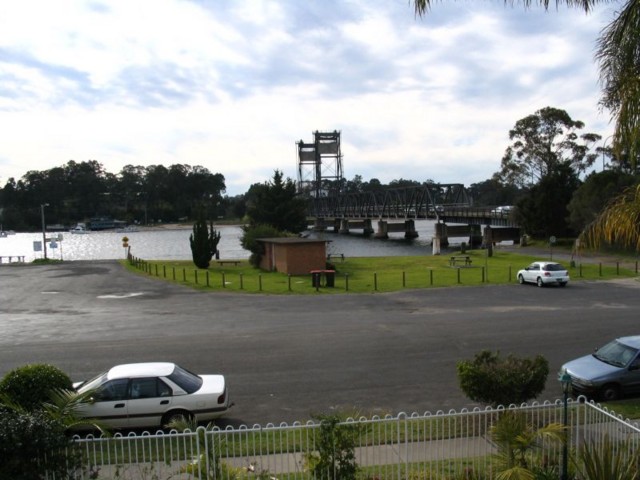
According to the original plan, after spending about a week in Melbourne, we would start our winding way along the south-east coast of Australia until reaching Sydney. This was estimated to take about a week, and to take us through sleepy country towns, picturesque bays, lush forest land and beautiful coasts.
Alternatively, we were to leave Melbourne towards the north, along the Hume highway, reaching Canberra and ultimately Sydney. This had the advantage of being faster and of letting us see Australia's capital, but all the tourist books warned that the drive was boring.
In the end, what dictated our choice was the mood we were in on the day we started driving. Melbourne left us with the feeling that we saw everything there is to see, and we should now be heading home as quickly as possible. After the day-long trip of the Great Ocean Road, we had quite enough of long, winding, coastal roads and the sleepy towns that thrive along them, and there was no way we were going to go through a week of that. We therefore decided to head up to Canberra as quickly as possible.
Leaving Canberra, however, we were in a much better mood, and we decided to do the undoable: we left Canberra towards Queanbeyan, passed north of the Snowy Mountains and made our way through thick eucalyptus woods that stretched as far as the car can drive down towards the coast. This was a tricky drive, the last half hour of which was done in falling darkness.
Waking up in the morning, however, we found this view peering at us outside the hotel window:

and that set the mood for a lovely trip up the remainder of the New South Wales coast into Sydney. (This last part, by the way, was an adventure in its own right, since this was the first time in which we were driving a car in Sydney, and we had no map or guide to help us find our way. Nevertheless, using what we remembered(?) from our earlier stay with Barak and Na'ama, we managed to locate their house without problems.)
So, working chronologically, we started in Melbourne. The way up along the Hume highway proved to be as boring as the books promised. Worse, Australians seem to have very different ideas from the rest of the world regarding what constitutes a highway. This looked like your ordinary main road, rather than like the busiest highway in the continent. In areas it was two lanes on each side, in which case it was a 100km/h road. Other times it had two lanes altogether, in which case it was a 90km/h road. All the times it was raining. Heavily.
The other constants along the Hume highway are that there are plenty of signs telling you that you should rest, eat something, drink something, etc., so as not to fall asleep while you drive (these signs are posted regularly on every major road in Australia), but there are no decent rest stops anywhere on the road. In roughly 1000 kilometers of road, there was only one rest-stop that actually had some fast-food restaurants and a lavatory. I was amazed.
The only town directly on the Hume highway is Albury. By now, the highway bi-passes every other town. Therefore, when we wanted to stop for lunch on the first day, we actually had to get off the road and drive for five minutes before reaching some nameless town.
It's quite amazing to see these towns close up. There is a main street and nothing else. It was eerily like something out of "Little House on the Prairie". Obviously, no-one in town was in any hurry to any big city. Nor were they farmers. So, what, pray tell, do they do other than provide services for each other? (The bakery, the clothing-shop, etc. - these were all very prominent on the main street.)
In any case, the most memorable thing about this town is that it seemed to have its own weather. After two hours of driving in the pouring rain, we parked here on the main street and enjoyed half an hour of lunch in the sun-light. Then, going back to the road, it started raining again and didn't stop until we reached Canberra.
Our next stop was Albury. Due to its prominence on the Hume highway, this is a town that swelled to a size much larger than any other along the Hume, and most of it provides services for those who, like us, were there for a sleep-over along the way.
We came in, passed through the tourist information center, asked about hotels with swimming pools and other facilities, asked about cinema complexes, asked about shopping malls, asked about good restaurants. Having finished that, we drove to the nearest hotel, went into a room and never left it until the next morning. We were so dog tired.
Even though the hotel had a restaurant that was located just one flight of stairs above our room, we couldn't bring ourselves to put on our coats and go there. Instead, we ordered a three-course meal in room service. I, personally, am opposed to room service, on account of it being needlessly expensive. However, after we ate the entire meal and had a little more strength than before, Orit jotted down some calculations and came up with the conclusion that this was the least expensive meal we've had in the entire duration of the trip. Well, they always told me that things are cheaper when you get a little further away from the city...
(In Australia, incidentally, when you're within a half-day's drive of a major city, you don't get to see "Sydney" or "Melbourne" on road signs anymore. Instead, the place is directed as "City".)
We reached Canberra with no further incident, and three days later continued on the road to Sydney. As mentioned, we didn't take the Hume highway for this, and, instead, cut through half a day's drive of forest towards the shore.
This part of the drive (as most others) was done thankfully by Orit. The road kept meandering and meandering, all the while getting narrower and narrower. For us, this was pretty scary, as we still didn't get the hang of driving on the left, and it turned out that for us the worst thing was trying to center the car in the middle of its lane. You see, when you're driving with a right-sided wheel, the center of the lane should be to your left, but as soon as you stop paying attention, the center of the lane creeps back to be on your right, as you're used to seeing it, and this means that half of the car is poking to the left of the lane.
When you're driving on a road with one lane for each direction and no margins, that is scary. To make things worse, every once in a while we saw a car coming the opposite way with a big sign saying "WIDE LOAD", meaning that right behind it there was a truck carrying a house. Not fun.
Still, somehow we made it into Batesmans Bay, and started the morning up north, along the coast, in a much better mood. The little towns, bridges crossing small bays and view of the south pacific, all these were every bit as marvelous as people promised us. But we had a specific site in mind, because of which we chose this particular stretch of beach. We were out to see this:

This is the blow-hole on the coast, in a quaint little town called Kiama. The blow-hole itself is fenced around in a twenty-meter radius,
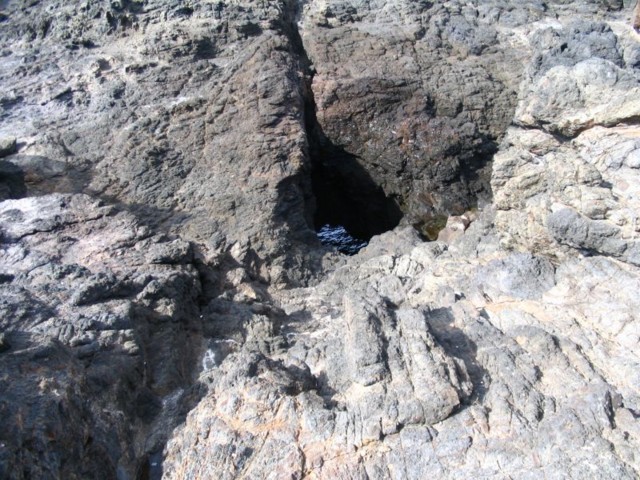
and this is largely because it erupts, every once in a while, in a water spout that is reportedly sixty meters in hight. That sounded impressive to us, so we decided to stop by. As the winds were up that day, we expected a spectacle, and, indeed, from afar we heard this blow-hole make roaring breathing noises.
Sadly, that was more or less all we saw. The eruptions of the blow-hole, though nice,
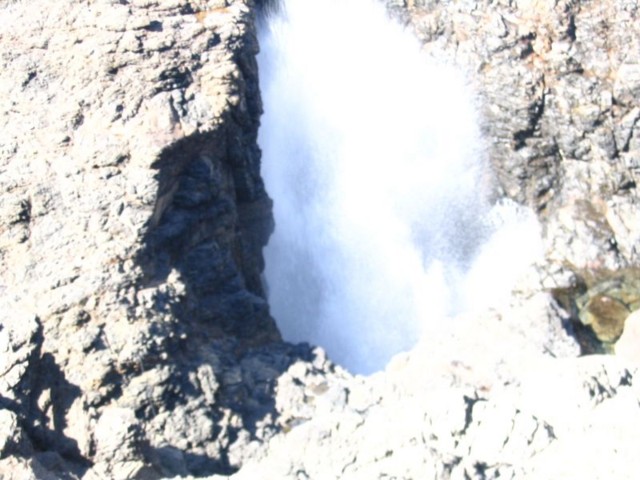
were nothing like what was reported.
When we asked the locals, they told us that the wind was, indeed, high, but in the wrong directions. As is, the wind pushed water away from the entrance to the blow-hole
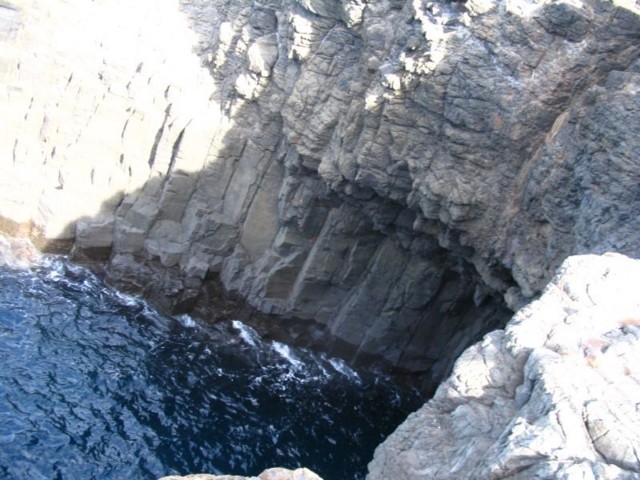
instead of towards it, so these eruptions are actually the smallest this little "geyser" knows how to make. Oh, well. At least we caught a good view of the South Pacific (the Tasmanian Sea)
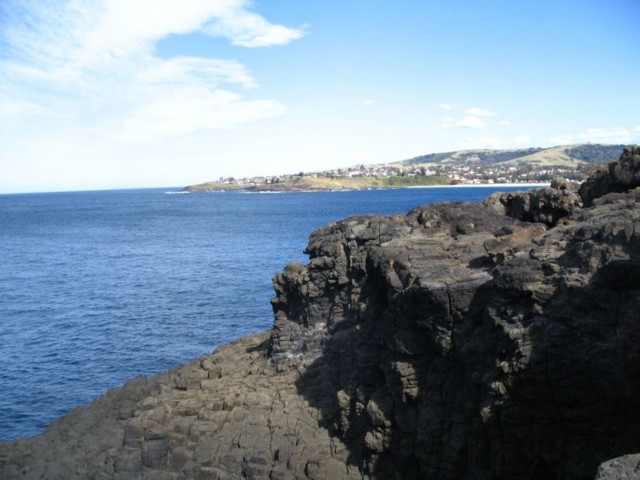
and got to take this
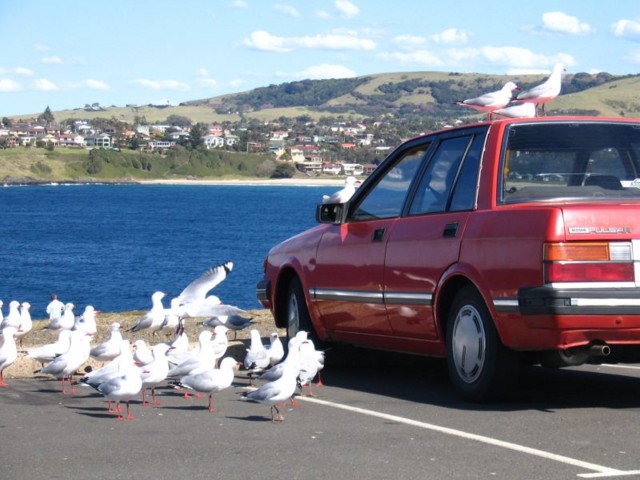
surrealistic picture, too.
For the complete set of pictures on the way from Canberra to Sydney, visit our drive gallery.